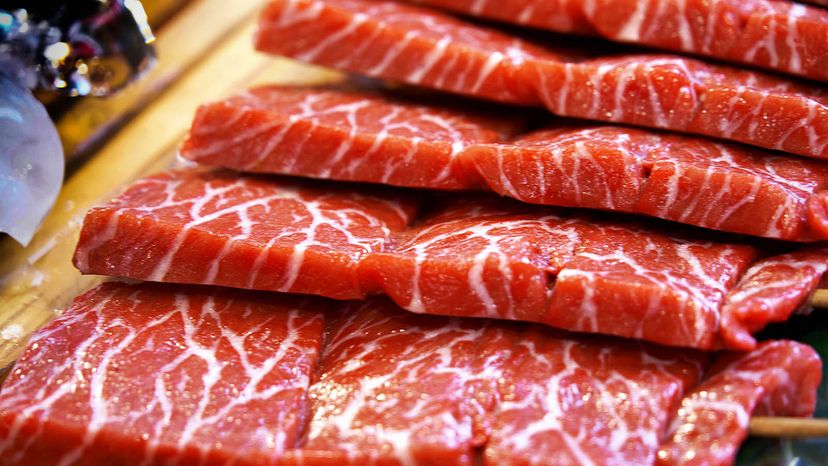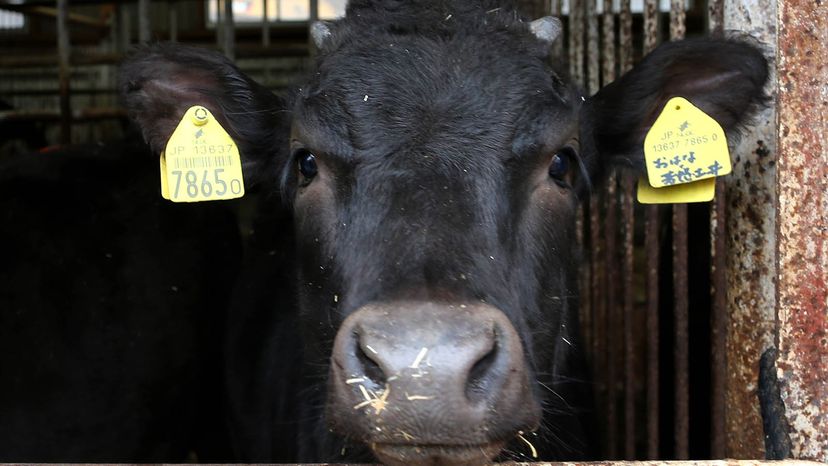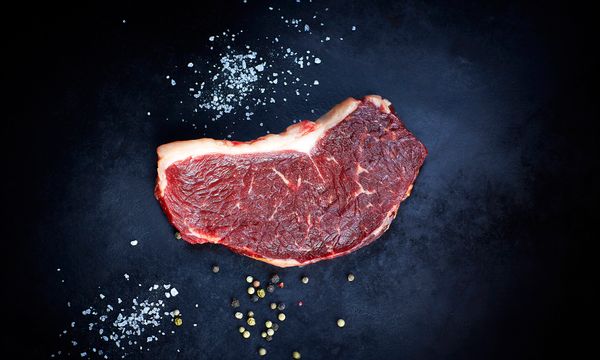
For the esteemed meat-heads who'll happily put down hundreds — if not thousands — of dollars for a fine steak, no cut of beef gets people quite as excited as wagyu. Translating literally to "Japanese cow" in English, wagyu is a type of fatty, tender, delectable beef that's among the most expensive in the world.
Valued at around $200 per pound (the rarest steak in the world, olive wagyu, can cost anywhere from $120 to over $300 for a steak), wagyu refers to any one of the four Japanese breeds of beef cattle (Japanese Black, Japanese Brown, Japanese Shorthorn and Japanese Polled) whose fatty, marbled meat has become the stuff of legend. Wagyu cattle are significantly different than their traditional American counterparts in terms of both size and strength. Bred for their physical endurance, Wagyu cattle actually run a bit smaller than beef cattle — but it's not their size that makes these cows such a hot commodity.
Advertisement
Wagyu beef contains, on average, about 300 percent more monounsaturated fat than normal beef, not to mention incredibly high levels of omega-3 and omega-6 — as well as a type of fatty acid called conjugated linoleic acid (CLA). These intra-muscular fat cells marble the meat throughout, acting as a sort of flavor injector in the steak. Since marbled fat melts at a lower temperature, the meat becomes rich, tender and juicy.
"The taste is really hard to describe," says Redditor Eric hey_im_cool, who wants to be known by his Reddit name only. The chef and wagyu fanatic is just one of nearly 500,000 members of r/AskCulinary — a subreddit dedicated to providing expert guidance for specific cooking problems. On any given day, you can find professional chefs and food lovers musing about this legendary cut of meat.
"I think searing it over medium-high in a stainless steel or cast iron pan is the way to go," adds the Redditor. "Around one minute per side depending on thickness, no oil needed. It's very hard to mess that up, even if you cook past your desired temperature you'll still be having the best steak of your life."
The Japanese beef grading system, based on yield, quality and marbling breaks down to five factors:
- Yield grade
- Marbling
- Meat color and brightness
- Firmness and texture of meat
- Color, luster and quality of fat
An "A5" is the absolute best you can get. The standards of grading beef consist of yield grade and quality grade. The “A” in “A5” means the yield grade (the standard of evaluating cutability or proportion of meat obtained from a certain part of the cow), while “5” is the quality grade. While the price varies, A5 wagyu can go for up to $250 per pound — that's about $15 per ounce.
Wagyu beef is heavily regulated in Japan, with mandatory progeny testing ensuring only the highest quality cattle are slaughtered. At up to $200 a pound, wagyu calves can sell for up 40 times the price of U.S. cattle — fetching around $30,000 for an adult cow. The level of attention to the cow doesn't begin in the slaughterhouse; wagyu cattle are fed up to five times longer (up to 700 days) than their U.S. counterparts.

"There are four breeds native to Japan," said Joe Heitzeberg, the co-founder and CEO of Crowd Cow in an interview with Robb Report. "Of those four breeds, one of the breeds is genetically unique. It has a genetic predisposition to create this crazy marbling of fat inside [the] muscle tissue. No other livestock does that." Along with a genetic predisposition to fine-grained, intramuscular marbling, the cows' healthy diet and low-stress levels contribute to the level of fat within the meat.
The size of Japan's cattle industry also plays a large role in the way the cows are treated. With feedlots holding anywhere from 10 to 100 cows (as opposed to thousands in American factory farms), farmers can dote over their cattle and create the low-stress environment necessary for melt-in-your-mouth marbled steak.
One popular — albeit sadly incorrect — belief about wagyu cows is that the cattle are hand-massaged by farmers and given beer. While we can't guarantee that a lone farmer hasn't gone off the rails and shared a PBR with a cow, it's widely agreed upon that this sort of attention is not an industry standard. Another misconception concerns the difference between wagyu and Kobe beef. It's actually pretty simple: wagyu is the breed and Kobe beef comes from the Kobe region of Japan.
Advertisement
